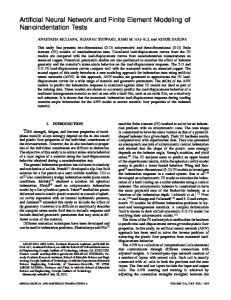Simulated soft tissue nanoindentation: A finite element study
- PDF / 5,948,338 Bytes
- 16 Pages / 612 x 792 pts (letter) Page_size
- 102 Downloads / 347 Views
Fernando Carrillo Department of Orthopaedic Surgery, University of California, San Francisco, California 94110; and Chemical Engineering Department, Escola Universitària d’Enginyeria Technica Industrial de Terrassa (EUETIT) – Polytechnic University of Catalonia, Terrassa 08222, Spain
Medhi Balooch Department of Restorative Dentistry, University of California, San Francisco, California 94143
Lisa Pruitt Department of Mechanical Engineering, University of California, Berkeley, California, 97420; and University of California—Berkeley/University of California—San Francisco Bioengineering Joint Graduate Group, San Francisco, California 94143
Christian Puttlitza) Department of Orthopaedic Surgery, University of California, San Francisco, California 94110; and University of California—Berkeley/University of California—San Francisco Bioengineering Joint Graduate Group, San Francisco, California 94143 (Received 15 November 2004; accepted 18 March 2005)
To address the growing interest in nanoindentation for biomaterials, the following finite element study investigated the influence of indentation testing protocol and substrate geometry on quasi-static and dynamic load-displacement behavior of linear viscoelastic materials. For a standard linear solid, the conventional quasi-static indentation modulus, EQS, fell between the instantaneous and equilibrium modulus of the model. EQS approached the equilibrium modulus only for indentation unloading times 1000 times greater than the characteristic relaxation time of the model. It was nearly insensitive to other changes in the indentation testing protocol, such as tip radius and penetration depth, exhibiting variations of only 5–10%. Dynamic nanoindentation provided a quantitatively accurate assessment of the complex dynamic modulus (within ±12%) for a range material of parameters at physiologically relevant testing parameters. Both quasi-static and dynamic moduli calculated from the irregular surfaces varied with the size and shape of the irregularities but were still within 10% of the smooth surface values for penetration depths larger than the dimensions of the surface irregularities. I. INTRODUCTION
The use of small animal models, such as murine, rat, and rabbit models, are currently being explored to help elucidate the mechanobiological mechanisms of clinically relevant conditions such as fracture healing and osteoarthritis progression.1,2 One of the main goals of these investigations is to develop a comprehensive view of the biomechanical structure–function relationships at the tissue and cellular level. While both biochemical and mechanical properties are important markers of tissue
a)
Address all correspondence to this author. e-mail: [email protected] DOI: 10.1557/JMR.2005.0247 J. Mater. Res., Vol. 20, No. 8, Aug 2005
http://journals.cambridge.org
Downloaded: 18 Mar 2015
integrity, histological analyses have primarily been used to characterize tissue specimens from these small animal models. The heterogeneous nature of these small tissue specimens precl
Data Loading...











